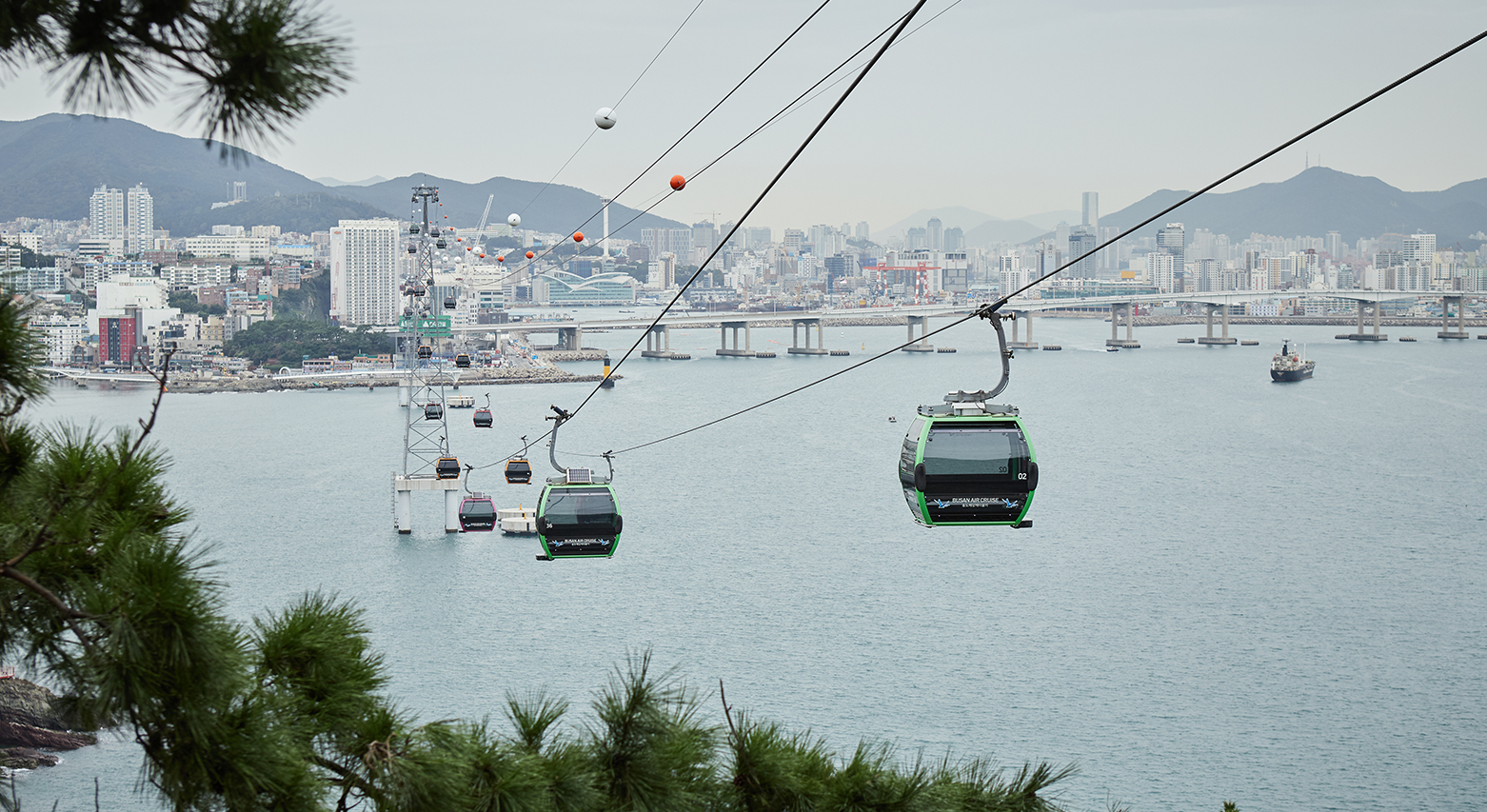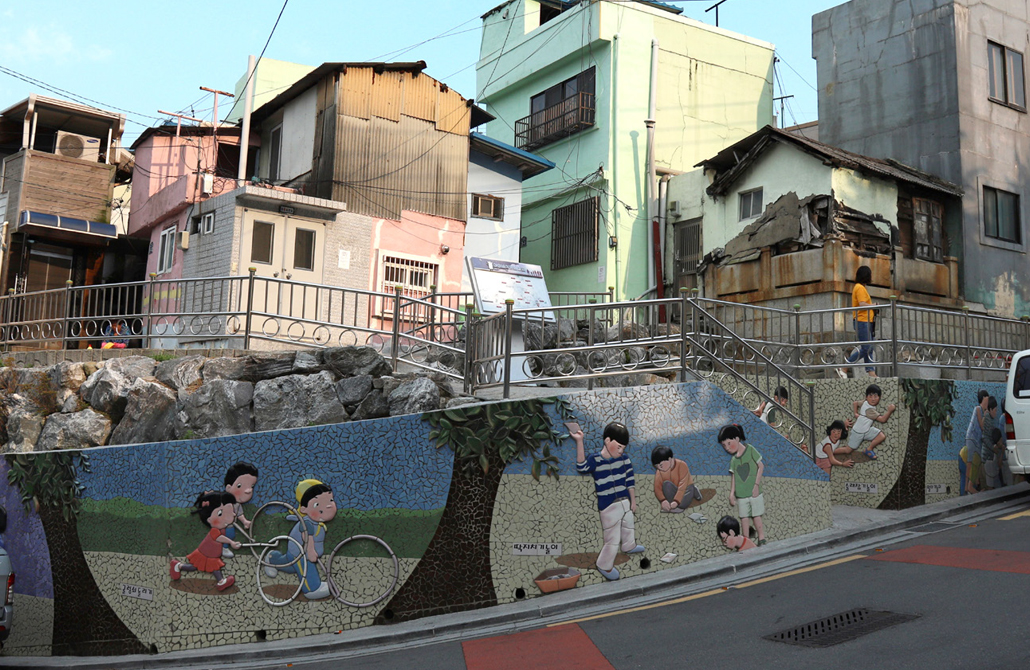
Contents










Story · Written by Kwon Yong Min Photographed by Studio Kenn
Inside Busan:
Sanbok Road
Though Busan is most famous for its beaches, what truly defines the city is
the mountains that sit around it and form a sort of cauldron. Sanbok (Mountainside) Road
goes around the mountainside to connect villages and their people.
Amnam Park, located in the Amnam-dong neighborhood of Busan, combines the city’s full variety of scenes and displays with woods like primordial forests, steep cliffs and the sea.
The 2.2-km trail between the park and Songdo Beach has a low difficulty level for hiking according to a ranking table of national forest trails compiled by the Korea Forest Service. In addition to fine views, the trail has sports facilities like an administrative center, a tennis court and an ice rink and convenience venues.
Moving forward, the scent of the sea quietly sweeps in via the frequent breeze grazing my body. Many people stand on rocks, mostly anglers perpetually killing time after casting their fishing rods. The park’s seashore road is frequented by anglers because of its sea fishing-friendly setup.

Songdo Beach
Walking along the seashore road of Amnam Park brought me to Songdo Beach. Considered Korea’s best beach, Songdo boasts a beautiful coastline. In the number of users per unit area, this beach is second to none among beaches in Busan as the best place in the city to enjoy the sea.
Also famous here are the skywalk and the cable car. Often called the cloud trail, the skywalk is a trail connecting turtle-shaped islands. Because the bridge has a floor made of transparent glass, visitors can more fully appreciate the waves below, feeling like they are standing in the middle of an ocean without getting wet.
For those who want to view all of Songdo, riding the cable car is ideal. Starting from Songrim Park and going to Amnam Park after crossing the sea, driving over Busan waters is an experience. The surface of the water glitters like droplets of light underneath visitors’ feet and trees densely packed in all directions extend without end. This spectacle helps visitors relax.

Amnam Park is a great place to enjoy both forests and the sea, leading to Songdo Beach and a cable car station.
Bus No. 186
To explore inner Busan, I took an intra-city bus to see the private lives of city residents. Bus No. 186 leaves Taejongdae and runs a route leading to Sasang Station via Sanbok Road. Sitting on a seat where the sun was shining, I turned my head and gazed out the window. The road curved deeply like skin wrinkles and the buildings along the road stood shoulder to shoulder.
Sanbok Road is rugged with a steep slope and an uneven road. The plethora of residential areas is crowded and sophisticated, and within each is a series of labyrinthine alleys. Seeing Busan’s inner scenery for the first time, I felt as if I was looking at long panoramic photos.

The city bus that passes through the historical Diorama offers one of the best views of Sanbok Road and its surroundings.
Confluence of History and Life
Getting off the bus at the Yeongju three-way intersection got me to an observatory offering a great view of the villages above Sanbok Road. The scenery of the entire area seemed like a diorama or a gigantic exhibit of history.
While scrutinizing the place with my eyes, I saw housewives hanging laundry, children chatting while eating with their mouths full and the elderly leisurely fanning themselves. Each of them formed a part of a familiar and comforting scene.

Choryang-dong has a panoramic view of the hillside village.
Roofless Museum
I left the observatory and went on to alleys with murals painted on their walls in a place called Dakbatgol Happy Village. Nicknamed a “roofless museum,” the village is famous for having numerous daknamu (paper mulberry trees), which inspired the name “Dakbatgol.” There, the method of making Hanji (traditional Korean paper) is shown as well as a variety of handicrafts using paper made from the trees, in addition to a daknamu craft exhibition hall.
Paintings and writing on every wall of the village were made by residents, who applied colors like they were dressing the walls in new clothes. They also wrote on the walls poems based on their experiences and famous quotes from authors. Is this why they’re happy? The alleys felt secluded and quaint enough to walk around in, and each inscription had its own unique story.
After climbing the alleys to the vicinity of Mangyang-ro, I reached the 192-step “Stairs of Hope,” which have many flowers painted on their steep slopes. The stairs got their name from a superstition that making a wish while climbing up and down the stairs will grant that wish.
Another staircase considered to be among Korea’s 100 most beautiful roads as chosen by the Ministry of Construction and Transportation had 40 steps. They have seen no change despite the passage of time, and the feeling of the alleys remains more intact than in other places. Residents sell goods on these stairs as well as share greetings, and even throw in a little extra for buyers they enjoy talking to.
 Ami-dong is a village decorated with tombstones and murals. © Busan Metropolitan City
Ami-dong is a village decorated with tombstones and murals. © Busan Metropolitan City The steep slopes and stairs of Busan contain stories from Korea’s modern history. © Busan Metropolitan City
The steep slopes and stairs of Busan contain stories from Korea’s modern history. © Busan Metropolitan City This view on the trail along Sanbok Road features a spectacular view.
This view on the trail along Sanbok Road features a spectacular view.Panoramic City View
Nuribaragi Observatory offers a panoramic view of downtown Busan. The term “Nuribaragi” is a combination of nuri, a pure Korean word meaning “world,” and baragi, meaning “to look at.” This signifies that everyone can appreciate the city’s scenery while enjoying a leisurely rest.
At the entrance was a gate that embodied the origin of Cheonmasan Mountain, whose name literally means “a horse that came down from heaven.” In the heart of the Nuribaragi Rest Area stood the so-called Sound Tree, which looked like a cloud hanging on a tree. A wind chime shook, emitting a clear sound. The wind was clearer and bluer since it passed over the seas of Busan. The observatory offered a full view of Yeongdo, Namhangdaegyo Bridge and Taejongdae to the left and Seomyeon and Yongdusan Park, Busan Tower and Yeongdodaegyo Bridge to the right. Magnificent views of Busan as seen here seemed like masterpieces of art.
The landscape seen from the observatory was expansive and round, with roads and scenes combining to create a magnificent view along with scenes of people moving about.

The panoramic view at the top of Nuribaragi Observatory makes the latter a popular tourism attraction on Sanbok Road. © Busan Metropolitan City
Other Articles















